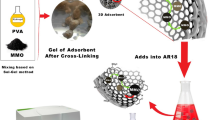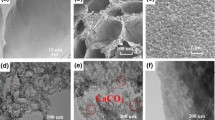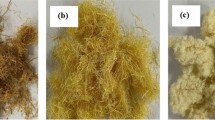Abstract
Cheap and efficient adsorbents to remove contaminants of toxic dye molecules from wastewater are strongly in demand for environmental reasons. This study provides a novel design of a monolithic adsorbent from abundant materials via a facile synthetic procedure, which can greatly reduce the problems of the tedious separation of adsorbents from treated wastes. A hierarchically porous cellulose/activated carbon (cellulose/AC) composite monolith was prepared by thermally-induced phase separation of cellulose acetate in the presence of AC, using a mixture of DMF and 1-hexanol, followed by alkaline hydrolysis. The composite monolith had alarge specific surface area with mesopore distribution. It not only showed high uptake capacity towards methylene blue (MB) or rhodamine B (RhB) but could also simultaneously adsorb MB and RhB from their mixture, in which the adsorption of one dye was not influenced by the other one. Remarkable effects of solution pH, initial concentration of dye (C 0), contact time, adsorbent dosage and temperature on the adsorption of MB and RhB onto the composite monolith were demonstrated. The binding data for MB and RhB adsorption on the composite monolith fitted the Freundlich model well, suggesting a heterogeneous surface of the composite monolith. The monolith could retain around 90% of its adsorption capacity after 8 times reuse. These data demonstrate that the cellulose/AC composite monolith has a large potential as a promising adsorbent of low cost and convenient separation for dye in wastewater.











Similar content being viewed by others
References
Ai L, Zeng Y, Jiang J (2014) Hierarchical porous BiOI architectures: facile microwave nonaqueous synthesis, characterization and application in the removal of Congo red from aqueous solution. Chem Eng J 235:331–339
Balathanigaimani M, Lee M-J, Shim W-G, Lee J-W, Moon H (2008) Charge and discharge of methane on phenol-based carbon monolith. Adsorption 14:525–532
Balathanigaimani MS, Shim W-G, Lee J-W, Moon H (2009) Adsorption of methane on novel corn grain-based carbon monoliths. Microporous Mesoporous Mater 119:47–52
Bradbury AGW, Sakai Y, Shafizadeh F (1979) A kinetic model for pyrolysis of cellulose. J Appl Polym Sci 23:3271–3280
Chairat M, Rattanaphani S, Bremner JB, Rattanaphani V (2005) An adsorption and kinetic study of lac dyeing on silk. Dyes Pigments 64:231–241
Chen S, Yue Q, Gao B, Li Q, Xu X (2011) Removal of Cr(VI) from aqueous solution using modified corn stalks: characteristic, equilibrium, kinetic and thermodynamic study. Chem Eng J 168:909–917
Choong TS, Wong TN, Chuah TG, Idris A (2006) Film-pore-concentration-dependent surface diffusion model for the adsorption of dye onto palm kernel shell activated carbon. J Colloid Interface Sci 301:436–440
Coleman N, Hench L (2000) A gel-derived mesoporous silica reference material for surface analysis by gas sorption 1. Textural features. Ceram Int 26:171–178
Dong Z, Wang D, Liu X, Pei X, Chen L, Jin J (2014) Bio-inspired surface-functionalization of graphene oxide for the adsorption of organic dyes and heavy metal ions with a superhigh capacity. J Mater Chem A 2:5034–5040
Dridi-Dhaouadi S, Douissa-Lazreg NB, M’Henni MF (2011) Removal of lead and Yellow 44 acid dye in single and binary component systems by raw Posidonia oceanica and the cellulose extracted from the raw biomass. Environ Technol 32:325–340
Freundlich HMF (1906) Over the adsorption in solution. J Phys Chem A 57:385–470
Gopiraman M, Bang H, Yuan G, Yin C, Song KH, Lee JS et al (2015) Noble metal/functionalized cellulose nanofiber composites for catalytic applications. Carbohydr Polym 132:554–564
He X, Male KB, Nesterenko PN, Brabazon D, Paull B, Luong JH (2013) Adsorption and desorption of methylene blue on porous carbon monoliths and nanocrystalline cellulose. ACS Appl Mater Interfaces 5:8796–8804
Ho Y-S, McKay G (1999) Pseudo-second order model for sorption processes. Process Biochem 34:451–465
Kyzas GZ, Bikiaris DN (2015) Recent modifications of chitosan for adsorption applications: a critical and systematic review. Mar Drugs 13:312–337
Lagergren S (1898) Zur Theorie der Sogenannten Adsorption Geloester Stoffe. Kungliga Sven Vetensk Handl 24:1–39
Langmuir I (1916) The constitution and fundamental properties of solids and liquids. Part I. Solids J Am Chem Soc 38:2221–2295
Lillo-Ródenas MA, Cazorla-Amorós D, Linares-Solano A (2010) Benzene and toluene adsorption at low concentration on activated carbon fibres. Adsorption 17:473–481
Liu K, Chen L, Huang L, Lai Y (2016) Evaluation of ethylenediamine-modified nanofibrillated cellulose/chitosan composites on adsorption of cationic and anionic dyes from aqueous solution. Carbohydr Polym 151:1115–1119
Malekbala MR, Khan MA, Hosseini S, Abdullah LC, Choong TSY (2015) Adsorption/desorption of cationic dye on surfactant modified mesoporous carbon coated monolith: equilibrium, kinetic and thermodynamic studies. J Ind Eng Chem 21:369–377
Menon V, Komarneni S (1998) Porous adsorbents for vehicular natural gas storage: a review. J Porous Mater 5:43–58
Okada K, Nandi M, Maruyama J, Oka T, Tsujimoto T, Kondoh K, Uyama H (2011) Fabrication of mesoporous polymer monolith: a template-free approach. Chem Commun 47:7422–7424
Park SB, Fujimoto T, Mizohata E, Inoue T, Sung MH, Uyama H (2013) Fabrication of poly (gamma-glutamic acid) monolith by thermally induced phase separation and its application. J Microbiol Biotechnol 23:942–952
Radha G, Balakumar S, Venkatesan B, Vellaichamy E (2017) A novel nano-hydroxyapatite—PMMA hybrid scaffolds adopted by conjugated thermal induced phase separation (TIPS) and wet-chemical approach: analysis of its mechanical and biological properties. Mater Sci Eng C 73:164–172
Shakir K, Elkafrawy AF, Ghoneimy HF, Elrab Beheir SG, Refaat M (2010) Removal of rhodamine B (a basic dye) and thoron (an acidic dye) from dilute aqueous solutions and wastewater simulants by ion flotation. Water Res 44:1449–1461
Sun X, Uyama H (2013) A poly (vinyl alcohol)/sodium alginate blend monolith with nanoscale porous structure. Nanoscale Res Lett 8:4745–4751
Sun X, Fujimoto T, Uyama H (2013) Fabrication of a poly (vinyl alcohol) monolith via thermally impacted non-solvent-induced phase separation. Polym J 45:1101–1106
Wang G, Uyama H (2015) Reactive poly (ethylene-co-vinyl alcohol) monoliths with tunable pore morphology for enzyme immobilization. Colloid Polym Sci 293:2429–2435
Wang G, Xin Y, Uyama H (2015) Facile fabrication of mesoporous poly (ethylene-co-vinyl alcohol)/chitosan blend monoliths. Carbohydr Polym 132:345–350
Wu Z, Cheng Z, Ma W (2012) Adsorption of Pb(II) from glucose solution on thiol-functionalized cellulosic biomass. Bioresour Technol 104:807–809
Xin Y, Fujimoto T, Uyama H (2012) Facile fabrication of polycarbonate monolith by non-solvent induced phase separation method. Polymer 53:2847–2853
Xin Y, Xiong Q, Bai Q, Miyamoto M, Li C, Shen Y, Uyama H (2017) A hierarchically porous cellulose monolith: a template-free fabricated, morphology-tunable, and easily functionalizable platform. Carbohydr Polym 157:429–437
Yang S, Zhao Y, Chen R, Feng C, Zhang Z, Lei Z, Yang Y (2013) A novel tablet porous material developed as adsorbent for phosphate removal and recycling. J Colloid Interface Sci 396:197–204
Yi FY, Zhu W, Dang S, Li JP, Wu D, Li YH, Sun ZM (2015) Polyoxometalates-based heterometallic organic–inorganic hybrid materials for rapid adsorption and selective separation of methylene blue from aqueous solutions. Chem Commun 51:3336–3339
Yoneda S, Han W, Hasegawa U, Uyama H (2014) Facile fabrication of poly (methyl methacrylate) monolith via thermally induced phase separation by utilizing unique cosolvency. Polymer 55:3212–3216
Zhang L, Gao H, Liao Y (2016) Preparation and application of Poly(AMPS-co-DVB) to remove Rhodamine B from aqueous solutions. React Funct Polym 104:53–61
Zhu HY, Fu YQ, Jiang R, Jiang JH, Xiao L, Zeng GM et al (2011) Adsorption removal of congo red onto magnetic cellulose/Fe3O4/activated carbon composite: equilibrium, kinetic and thermodynamic studies. Chem Eng J 173:494–502
Acknowledgments
This study is financially supported by the Natural Science Foundation of China (No. 21675125), Amygdalus pedunculata Engineering Technology Research Center of State Forestry Administration, Key laboratory of Yulin Desert Plants Resources, a Grant-in-Aid for Scientific Research from the Japan Society for the Promotion of Science (Nos. 16K14081, 17H03114), and the Hundred Talents Program, Shaanxi Province, P. R. China.
Author information
Authors and Affiliations
Contributions
Author contributions
The paper was written through contributions of all authors. All authors have given approval to the final version of the paper.
Corresponding authors
Ethics declarations
Conflicts of interest
The authors declare no conflict of interest related to this research work.
Electronic supplementary material
Below is the link to the electronic supplementary material.
Rights and permissions
About this article
Cite this article
Bai, Q., Xiong, Q., Li, C. et al. Hierarchical porous cellulose/activated carbon composite monolith for efficient adsorption of dyes. Cellulose 24, 4275–4289 (2017). https://doi.org/10.1007/s10570-017-1410-y
Received:
Accepted:
Published:
Issue Date:
DOI: https://doi.org/10.1007/s10570-017-1410-y




